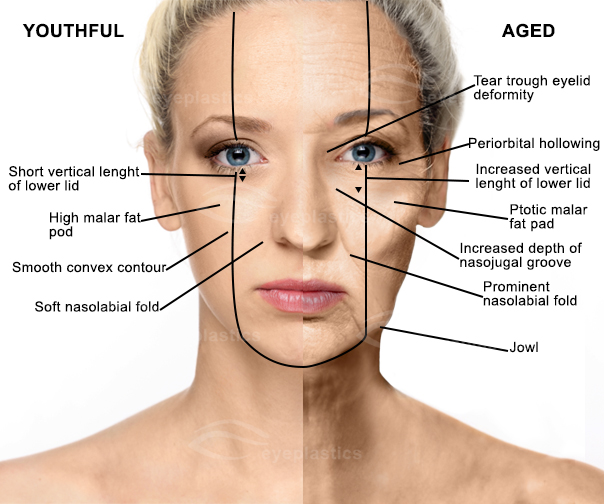A face-lift or rhytidectomy is a cosmetic surgical procedure of the face and neck performed to improve the loose skin that causes wrinkles or rhytids. A face-lift smooths out the loose skin over your face and neck, improving the visible signs of aging and giving you a more youthful appearance. As we get older, skin and tissues naturally lose their elasticity. This leads to sagging and wrinkles. A facelift, also known as rhytidectomy, is a surgical procedure that lifts and tightens these facial tissues.
WHAT IS FACE LIFT?
It’s like setting the clock back…as it works for a more youthful appearance by removing major wrinkles and sagging skin by tightening of the facial and neck muscles as well as the removal of any excess skin.
As people age, the effects of gravity, exposure to the sun, and the stresses of daily life can be seen in their faces. Deep creases form between the nose and mouth; the jaw line grows slack and jowly; folds and fat deposits appear around the neck. Not only does a facelift improve facial appearance but also has a dramatic effect on the neck, enhancing its contour and profile.
WHAT TO EXPECT?
After the surgery, your doctor will likely prescribe pain medication. You may or may not have some pain or discomfort along with swelling and bruising. This is all normal. Your doctor will give you instructions on when to remove any dressings or drains and when to make a follow-up appointment. Once the swelling goes down, you’ll be able to see the difference in how you look. As far as your skin “feeling” normal, this usually takes several months. Typically, give yourself about two weeks before resuming a normal level of daily activity. For more strenuous activity, like exercise, wait about four weeks. Everyone is different, though, so ask your doctor when you can expect to be able to resume your usual activities.
To help extend the results of your facelift, moisturize your face daily, protect it from the sun, and live a generally healthy lifestyle. The results of a facelift aren’t guaranteed. You might not get your desired results from one surgery. Sometimes a subsequent surgery is necessary. Talk with your doctor about what you can do to help ensure a successful facelift and what you can reasonably expect from the surgery.
WHO IS IT FOR?
The best candidate for a face lift is a man or woman whose face and neck have begun to sag, but whose skin still has some elasticity and whose bone structure is strong and well-defined. Most patients are in their forties to sixties, but facelifts can be done successfully on people in their seventies or eighties as well. A facelift can make you look younger and fresher, and it may enhance your self- confidence in the process. But it can't give you a totally different look, nor can it restore the health and vitality of your youth. Before you decide to have surgery, think carefully about your expectations and discuss them with your surgeon.
HOW IS IT PERFORMED?
Facelifts vary depending on your desired results. Traditionally, an incision is made in the hairline near the temples. The incision goes in front of the ear, down in front of and hugging the earlobe, then back to the lower scalp behind the ears. Fat and excess skin may be removed or redistributed from the face. The underlying muscle and connective tissue are redistributed and tightened. If there’s minimal skin sagging, a “mini” facelift may be done. This involves shorter incisions.
If a neck lift is also going to be performed, the excess skin and fat will be removed. The skin of the neck will be tightened and pulled up and back. This is often done through an incision just under the chin. The incisions often have dissolvable sutures or skin glue. In some cases, you might need to return to the surgeon to have stitches removed. The incisions are made in such a way that they blend with your hairline and facial structure. You’ll often have a surgical drainage tube after surgery as well as bandages wrapping your face.
WHAT POSTOPERATIVE CARE IS REQUIRED?
Post-operative care is very important. Unnecessary pain and the complications of infection and swelling may be minimized if the instructions are followed carefully. Sometimes the after effects of surgery are quite minimal, so not all these instructions may apply. Common sense will often dictate what you should do. However, when in doubt, follow these guidelines or call our office any time for clarification.
Facelift surgery is one of the most dramatic procedures for looking younger. Nothing can improve the jowl and neck more than the facelift. The success of the surgery lies in the hands of the patient as well as the surgeon. The best surgeon on earth will not obtain satisfactory results if the patients do not properly care for themselves after surgery. In order to take advantage of all the positive changes associated with the facelift the patient must pay close attention to the recovery process.
RISK AND COMPLICATIONS
There are risks to any medical procedure, including a facelift. Risks can include:
Anesthesia risks, bleeding, infection, cardiac events, blood clots, pain or scarring, hair loss at the incision sites, prolonged swelling, and problems with wound healing.
RESULTS
While most people are presentable to the public within 10-14 days, it will take 2-3 months for the face to feel "back to normal" in terms of texture, sensibility and loss of tightness. As swelling and bruising subside, the visible improvements of a facelift appear. Your final result should not only provide a more youthful and rested appearance, but also help you feel more confident about yourself. Although good results are expected, there can be no guarantee. In some situations, it may not be possible to achieve optimal results with a single surgical procedure and another surgery may be necessary.
© Copyright 2021 All Rights Reserved



